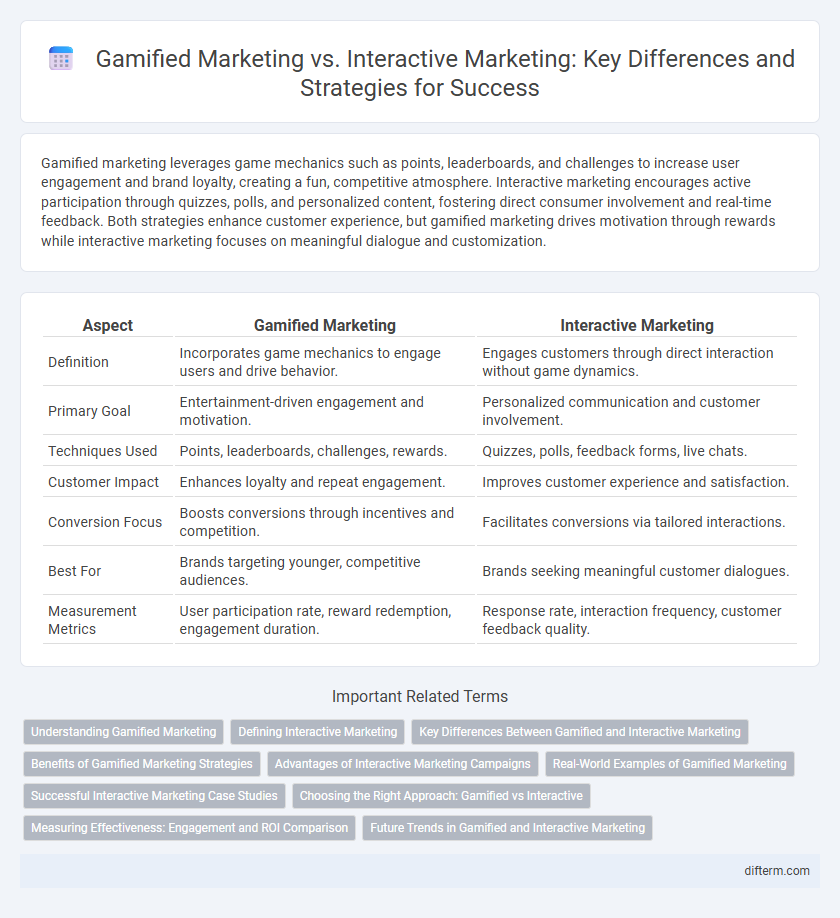Gamified marketing leverages game mechanics such as points, leaderboards, and challenges to increase user engagement and brand loyalty, creating a fun, competitive atmosphere. Interactive marketing encourages active participation through quizzes, polls, and personalized content, fostering direct consumer involvement and real-time feedback. Both strategies enhance customer experience, but gamified marketing drives motivation through rewards while interactive marketing focuses on meaningful dialogue and customization.
Table of Comparison
| Aspect | Gamified Marketing | Interactive Marketing |
|---|---|---|
| Definition | Incorporates game mechanics to engage users and drive behavior. | Engages customers through direct interaction without game dynamics. |
| Primary Goal | Entertainment-driven engagement and motivation. | Personalized communication and customer involvement. |
| Techniques Used | Points, leaderboards, challenges, rewards. | Quizzes, polls, feedback forms, live chats. |
| Customer Impact | Enhances loyalty and repeat engagement. | Improves customer experience and satisfaction. |
| Conversion Focus | Boosts conversions through incentives and competition. | Facilitates conversions via tailored interactions. |
| Best For | Brands targeting younger, competitive audiences. | Brands seeking meaningful customer dialogues. |
| Measurement Metrics | User participation rate, reward redemption, engagement duration. | Response rate, interaction frequency, customer feedback quality. |
Understanding Gamified Marketing
Gamified marketing leverages game mechanics like points, badges, and leaderboards to engage customers and drive behavior, creating an immersive brand experience. This strategy enhances customer loyalty and increases retention by making interactions enjoyable and rewarding. Unlike general interactive marketing, gamified marketing specifically incorporates competition and achievement elements that motivate users through intrinsic and extrinsic incentives.
Defining Interactive Marketing
Interactive marketing involves creating dynamic and engaging experiences that encourage direct participation from consumers, utilizing tools such as quizzes, polls, and personalized content to foster deeper brand connections. Unlike gamified marketing, which incorporates game mechanics like points, badges, and leaderboards to motivate users, interactive marketing prioritizes real-time dialogue and customized interactions. This strategy enhances user engagement by responding adaptively to consumer inputs, driving higher conversion rates and customer loyalty.
Key Differences Between Gamified and Interactive Marketing
Gamified marketing incorporates game mechanics such as points, badges, and leaderboards to enhance user engagement and motivation, while interactive marketing focuses on two-way communication and active participation without necessarily including competitive elements. Gamified marketing drives user behavior through rewards and challenges, whereas interactive marketing prioritizes personalized experiences and real-time interactions to build deeper customer relationships. Key differences include the use of structured game elements in gamified marketing versus broader engagement techniques like quizzes, polls, and interactive videos in interactive marketing.
Benefits of Gamified Marketing Strategies
Gamified marketing strategies significantly enhance customer engagement by incorporating game mechanics such as points, rewards, and competition, which increase motivation and brand loyalty. These strategies improve data collection through interactive experiences, providing valuable insights into consumer behavior and preferences. Higher conversion rates and prolonged user interaction result from the immersive and entertaining nature of gamified campaigns, making them more effective than traditional interactive marketing approaches.
Advantages of Interactive Marketing Campaigns
Interactive marketing campaigns boost customer engagement by fostering two-way communication, enhancing brand loyalty through personalized experiences. These campaigns provide valuable data insights, enabling marketers to refine strategies and target audiences more precisely. Increased user participation in interactive marketing leads to higher conversion rates and improved customer satisfaction compared to traditional approaches.
Real-World Examples of Gamified Marketing
Gamified marketing leverages game design elements such as points, leaderboards, and rewards to increase customer engagement, exemplified by Nike's Run Club app, which motivates users through challenges and achievements. Interactive marketing, while also engaging, centers on two-way communication without necessarily incorporating competitive or reward-based mechanics. Coca-Cola's "Share a Coke" campaign demonstrates interactive marketing by personalizing product labels to encourage social sharing and customer interaction.
Successful Interactive Marketing Case Studies
Successful interactive marketing case studies reveal how brands engage consumers through immersive experiences that foster active participation and personalized content. Examples like Nike's use of interactive social media campaigns and Sephora's virtual makeup try-on tools showcase increased customer engagement and conversion rates. These cases highlight the importance of real-time feedback and user-driven content in driving brand loyalty and sales growth.
Choosing the Right Approach: Gamified vs Interactive
Choosing the right marketing approach hinges on campaign goals and audience engagement levels; gamified marketing leverages game mechanics like points, leaderboards, and challenges to boost user motivation and retention, while interactive marketing emphasizes two-way communication through quizzes, polls, and personalized content to deepen customer relationships. Gamified strategies excel in driving competition and long-term engagement, making them ideal for brand loyalty programs, whereas interactive marketing fosters real-time feedback and tailored experiences, enhancing customer insights and immediate interaction. Selecting between gamified and interactive marketing depends on whether the priority is to create immersive, game-like experiences or to facilitate direct, personalized consumer engagement.
Measuring Effectiveness: Engagement and ROI Comparison
Measuring effectiveness in gamified marketing centers on tracking user engagement through game mechanics such as points, badges, and leaderboards, which often lead to higher participation rates and prolonged interaction times. In contrast, interactive marketing effectiveness is assessed by analyzing click-through rates, time spent on interactive elements, and conversion rates, providing direct insight into consumer behavior and immediacy of response. Return on investment (ROI) in gamified campaigns can show long-term brand loyalty and customer lifetime value, whereas interactive marketing typically yields quicker ROI with measurable short-term sales impact.
Future Trends in Gamified and Interactive Marketing
Future trends in gamified marketing emphasize immersive experiences powered by augmented reality (AR) and virtual reality (VR), enhancing customer engagement and brand loyalty through personalized game mechanics. Interactive marketing advances through AI-driven chatbots and real-time data analytics, enabling dynamic content that adapts to user behavior and preferences for higher conversion rates. Integration of blockchain technology ensures transparency and rewards systems, fostering trust and incentivizing sustained user participation in both gamified and interactive campaigns.
Gamified marketing vs interactive marketing Infographic

 difterm.com
difterm.com